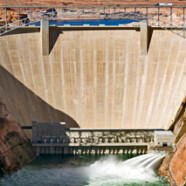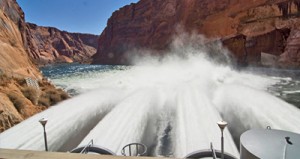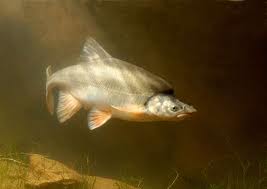
Re-examining Glen Canyon Dam Operations
We push off from Lees Ferry, powering our small boat up the Colorado River 15 miles to Glen Canyon Dam. The Sirens are beckoning me to join them under the gargantuan cement wall, but Stephen King plot lines stir my defenses against that seduction. I am willing to get close, but not too close. One cannot help thinking that a mere engineering marvel is keeping a lot of water (5,044,267,123,252 gallons on April 4, 2012) from tidal waving our little floater. It is frightening approaching this latter-day Leviathan. But it must be approached, and tamed. Glen Canyon Dam has been hard on Grand Canyon—its cultural sites, native fish and plants, and beaches.
Taming the Leviathan that is Glen Canyon Dam means getting control of its operations. For the past 15 years, operations have centered upon fluctuating flows that have eroded beaches and destabilized native fish habitat. Experiments trying other approaches have been conducted infrequently. But now the Department of Interior (Interior) has initiated the Long-Term Experimental and Management Plan Environmental Impact Statement (LTEMP EIS), a process that is re-examining Glen Canyon Dam operations. This re-examination presents a real opportunity for the public to join the conversation about what should happen at the dam and in Grand Canyon.
Glen Canyon Dam blocked the Colorado River in 1963, initiating a cascade of ecosystem problems. The dam traps about 90 percent of the annual sediment supply for Grand Canyon — the other 10 percent coming from tributaries within the canyon. The loss of sediment supply and the greatly increased rate of erosion from flows designed to maximize hydropower have set in motion the continual loss of sediment from Grand Canyon.
The loss of sediment from Grand Canyon has resulted in fewer and smaller beaches. It has also eliminated significant critical habitat for native fish. Sediment deposits create complex shorelines and underwater features that are used by native fish for spawning and rearing. Four of the eight species of native fish that once plied the waters of Grand Canyon have already been lost. A fifth species, the endangered humpback chub, is vulnerable to being lost from Grand Canyon because virtually all spawning and rearing habitat has disappeared from the mainstem.
The continual loss of sediment from Grand Canyon has also resulted in archaeological sites being exposed to erosion and impacts from visitors. Historically, these sites were protected with a regularly renewed layer of sediment derived from the beaches and transported by the wind. Without the influx of new sediment, we constantly lose these irreplaceable features of our cultural heritage.
The way in which water is released from Glen Canyon Dam has profound effects on the river corridor, the species living there, and the abundant cultural sites. Simply stated, water can be released as either steady flows or fluctuating flows. Neither flow regime impacts water supplies or water deliveries by the Colorado River; however, over the last 15 years, science has shown that fluctuating flows damage all the key resources in Grand Canyon–the beaches, the backwater habitats for native fish spawning and rearing, the native shoreline plants and animals, and cultural and archaeological sites. A recent report from Grand Canyon Monitoring and Research Center concluded that fluctuating flows following the last high-flow experiment quickly eviscerated the benefits created by the high flow.
Two types of flows are needed: 1) regular high flows under sediment-enriched conditions to deposit sediment from tributaries and to scour sediment from the bottom of the river to rebuild beaches and near shore habitat for native fish, and 2) seasonally-adjusted steady flows, based on the natural rhythms of the pre-dam river, which would preserve beaches, protect native fish habitat, and stabilize centuries-old cultural sites.
Ten Preliminary Alternatives in the LTEMP EIS
Ten preliminary alternative concepts have been developed by the LTEMP EIS team. These draft concepts are intended to cover a broad range of ideas that focus on various resources and could be analyzed in the LTEMP EIS process. Public comments will also be analyzed and a Draft Environmental Impact Statement released for public review by the end of the year.
It is critical that the LTEMP EIS alternatives consist of new dam operating criteria in concert with other management actions designed to meet the requirements of the Grand Canyon Protection Act. They must also be consistent with other laws, including those regarding water delivery, endangered species, cultural resources, and water quality. The alternative selected as best meeting these criteria should then be tested for the appropriate number of years to achieve the desired results.
Several of the alternative concepts appear capable of greatly benefiting Grand Canyon resources. One strong alternative is the “Naturally Patterned Flow Regime.” It would provide flows that mimic naturally patterned flows based on historic monthly averages, including regular high flows and seasonally-adjusted steady flows. Sediment augmentation and a temperature control device would also be used to achieve more natural sediment supplies and water temperatures.
Another valuable alternative concept being put forth is the “Structured Adaptive Management with Condition Decision-Tree” alternative. This esoteric-sounding alternative would implement a framework that uses a condition-dependent decision tree to maximize benefits to a wide range of resources. Its aim would be to provide a high degree of flexibility in response to annual conditions rather than a static prescription for all years. Everything would be on the table for this one, including high flows, steady flows, sediment augmentation, and temperature control device.
This is a landmark moment for Grand Canyon. The LTEMP EIS provides a public opportunity for Interior and the responsible agencies to accomplish something big — to meet in full the requirements of the Grand Canyon Protection Act. Interior has done a great job so far assembling public comments and developing preliminary alternative concepts. For more information on the re-examination of Glen Canyon Dam, see Interior’s LTEMP EIS website at: http://ltempeis.anl.gov. Please consider joining this important effort. Many are needed to tame a Leviathan!
~ by Nikolai Lash



